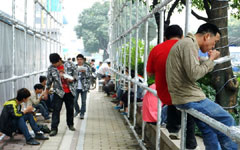Labor shortage looms in eastern China
(Xinhua) Updated: 2014-02-21 16:56BEIJING - "Wanted: lots of male and female workers," reads a banner hanging outside the Zhejiang Hiye Electronics factory in Shaoxing of East China's Zhejiang province.
"If you introduce me to one worker, you can get 200 yuan ($32.79)," said Hu Kefei, the company's board chairman.
|
 |
|
 |
|
 |
New official data has confirmed the difficulties, especially for factories in the relatively industrialized east, as more migrant workers are opting for central or western China, where wages are lower but so are living costs.
Meanwhile, many workers are turning to employment in or close by their hometowns rather than working in distant provinces.
Zhang Haomin, a migrant worker from Fuyang in East China's Anhui province, made such a decision when he left Hangzhou, capital of Zhejiang Province, before the Spring Festival, which fell on Jan 31 this year.
"My wife and I were earning some 8,000 yuan a month in total. It was relatively high, but the prices in Hangzhou are also high. We can barely save any money through a year's work. After the festival, I will first look for a job near my home before trying other places," Zhang said.
The government data proved a slowdown in the rate at which China's migrant worker numbers are growing.
The country had 269 million such workers in 2013, up 2.4 percent year on year, but the growth rate was 1.5 percentage points lower than in the previous year, said Yang Zhiming of the Ministry of Human Resources and Social Security at a press conference on Thursday.
The figures categorized migrant workers into those employed closer to home and those employed far from home. Among them, 166 million worked far from home, up 1.7 percent year on year, but the growth rate was 1.3 percentage points lower than the previous year.
"The slowdown shows that rural labor is no longer an undepletable pool," Yang said, pointing to the end of an era in which the supply of labor freed from farms seemed to be infinite.
Regional differences are pronounced. The growth rate of migrant workers in the east rose at a very low pace, though the region provided about 60 percent of jobs for migrants, Yang said.
- NHTSA says finds no 'defect trend' in Tesla Model S sedans
- WTO rare earth ruling is unfair
- Amway says 2014 China sales may grow 8%
- President Xi in Europe: Forging deals, boosting business
- CNOOC releases 2013 sustainability report
- Local production by Chery Jaguar Land Rover this year
- Car lovers test their need for speed in BMW Mission 3
- China stocks close mixed Monday

















